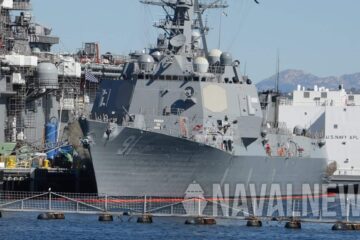From RIMPAC 2020 Public Affairs
The sinking exercise (SINKEX) provided participating units the opportunity to gain proficiency and confidence in their weapons and systems through realistic training that could not be duplicated in simulators.
“Simulation is a critical part of our training but there is nothing better than to conduct live fire training. Sinking exercises are an important way to test our weapons and weapons systems in the most realistic way possible. It demonstrates as a joint force we are capable of high-end warfare.”
Royal Australian Navy Capt. Phillipa Hay, commander, RIMPAC 2020 Task Force One
Former Navy vessels used in SINKEXs, referred to as hulks, are prepared in strict compliance with regulations prescribed and enforced by the Environmental Protection Agency under a general permit the Navy holds pursuant to the Marine Protection, Research and Sanctuaries Act.
Each SINKEX is required to sink the hulk in at least 1,000 fathoms (6,000 feet) of water and at least 50 nautical miles from land. Surveys are conducted to ensure people and marine mammals are not in an area where they could be harmed during the event.

Prior to being transported for participation in a SINKEX, each vessel is put through a rigorous cleaning process, including the removal of all liquid polychlorinated biphenyls (PCBs) from transformers and large capacitors, small capacitors to the greatest extent practical, and all trash, floatable materials, mercury or fluorocarbon-containing materials, and readily detachable solid PCB items. Petroleum is also cleaned from tanks, piping, and reservoirs.
A Navy environmental, safety and health manager and a quality assurance supervisor inspect the environmental remediation conducted in preparation of a vessel’s use in a SINKEX. Upon completion of the environmental remediation, the manager and supervisor provide signed certification of the work in accordance with EPA requirements.
Ex-Durham was a Charleston-class amphibious cargo ship commissioned on May 24, 1969, and was decommissioned on February 25, 1994. The ship was named for Durham, North Carolina, and served during the Gulf War.
Ten nations, 22 surface ships, one submarine, and approximately 5,300 personnel are participating in RIMPAC from Aug. 17 to 31 in the waters surrounding the Hawaiian Islands. The at-sea-only construct for RIMPAC 2020 was developed to ensure the safety of all military forces participating, and Hawaii’s population, by minimizing shore-based contingents, while striking a balance between combating future adversaries and the COVID-19 threat.
RIMPAC provides a unique training opportunity designed to foster and sustain cooperative relationships that are critical to ensuring the safety of sea lanes and security on the world’s interconnected oceans. RIMPAC 2020 is the 27th exercise in the series that began in 1971.





